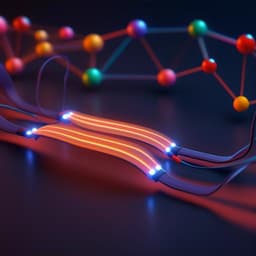Introduction
Ultrafast control of optical phenomena in nanophotonic materials like photonic crystals and metamaterials is crucial for both fundamental physics and industrial applications. Current methods, such as optical pulse irradiation and electrical pulse application, face limitations, particularly with increasing device size and optical power, due to the escalating energy requirements for external control. Other approaches using temperature-sensitive materials or micro-electromechanical systems suffer from slower response times. This research proposes a self-evolving photonic crystal to address these limitations, eliminating the need for external ultrafast stimuli. The concept relies on the ultrafast refractive index change induced by stimulated emission within photonic-crystal surface-emitting lasers (PCSELS), leading to spontaneous short-pulse generation. The self-evolving photonic crystal dynamically changes its photonic band structure without external stimuli, enabling high-power, short-pulse generation.
Literature Review
Previous studies have demonstrated dynamic control of optical phenomena in nanophotonic materials through optical pulse irradiation or electrical pulse application. However, optical methods require bulky, high-power external lasers, while electrical approaches struggle to achieve ultrafast (<ns) timescales. These challenges become more pronounced with larger devices and higher optical power demands. Alternative methods, such as employing temperature-sensitive phase-change materials or micro-electro-mechanical systems, have been explored but exhibit significantly slower response speeds. This research addresses these limitations by introducing a self-evolving photonic crystal, eliminating the need for external ultrafast control.
Methodology
The proposed self-evolving photonic crystal uses a gradually increasing lattice constant along the u-axis, incorporated into a p-n junction for current injection. A double-lattice photonic crystal structure is employed, featuring two holes shifted along the x and y axes. Numerical simulations using time-dependent three-dimensional coupled-wave theory model the device's transient behavior. A double-lattice photonic crystal with elliptical and circular air holes is simulated, adjusting the hole distance and filling factors to optimize lasing mode radiation constant and threshold margin. The lattice constant within the current injection region is varied using three gradient parameters (α₁, α₂, β), while the surrounding region's lattice constant remains fixed. α₁ represents the maximum lattice constant difference along the u-axis, influencing the mode-gap effect, and β represents the difference inside and outside the injection region, affecting in-plane loss. Biaxial gradation (α₂) compensates for carrier-induced refractive-index distribution due to spatial hole burning, improving beam divergence. Simulations compare uniform and graded photonic crystals under constant current injection, showing the generation of intermittent short-pulse trains in the latter. The simulated carrier density, band-edge frequency, and photon density distributions are analyzed at different time points during pulse generation. The robustness of the self-evolution effect is evaluated across various injection currents and gradient parameters. The 1-mm diameter self-evolving photonic crystal was fabricated using a process similar to conventional PCSEL fabrication. The device's performance was characterized using a streak camera, measuring the spatial-temporal evolution of the laser beam. The injection current dependence of the output power (peak and average), pulse width, and repetition frequency were investigated. Finally, the potential for pulse compression through dispersion compensation was explored using numerical simulations.
Key Findings
Numerical simulations confirmed the self-evolution principle, demonstrating the generation of short pulses (>100 W peak power, ≈30 ps pulse width) under constant uniform current injection. The simulations showed that the resonant mode initially localizes at the current injection edge due to the band-edge frequency gradation but moves toward the center as the gradation slope decreases because of the carrier-induced refractive index change during pulse amplification. Experimental results validated the simulations, achieving self-pulsation with a pulse width of <30 ps and a maximum peak power of >80 W—four times higher than previously reported for Q-switched semiconductor lasers without amplifiers. The pulse width decreased and the repetition frequency increased with higher injection current, consistent with simulations. A narrow beam divergence angle (θ₁/₂ ≈ 0.2°) was observed. Simulations further demonstrated that pulse compression via dispersion compensation could shorten the pulse width to 6.4 ps and increase peak power to 588 W, potentially reaching >1 kW by increasing the device diameter and gradient parameters.
Discussion
The experimental results successfully demonstrate high-peak-power short-pulse lasing based on the self-evolving photonic crystal concept. The elimination of external ultrafast stimuli, multi-section electrodes, and saturable absorbers simplifies the device architecture compared to conventional Q-switched lasers. The observed spontaneous wavelength chirping during each pulse offers the potential for further pulse compression through dispersion compensation, leading to even shorter pulses and higher peak powers. The achievement of >80 W peak power significantly surpasses previous results in Q-switched semiconductor lasers, opening new possibilities for ultrafast photonics applications.
Conclusion
This research introduces and experimentally validates the concept of a self-evolving photonic crystal for generating high-power, short optical pulses without external ultrafast control. The achieved >80 W peak power and <30 ps pulse width represent a significant advance in ultrafast photonics. Future work could focus on optimizing the device design for even shorter pulses and higher peak powers through refined dispersion compensation and exploring the potential for external control of the repetition frequency.
Limitations
The experimental peak power was slightly lower than the simulated value, possibly due to discrepancies between the radiation constant and injection current uniformity in the fabricated device and the simulation assumptions. The measured beam pattern showed slight elongation, indicating incomplete compensation of the carrier-induced refractive-index distribution along the y-axis. Further optimization of the fabrication process and device design could address these limitations.
Related Publications
Explore these studies to deepen your understanding of the subject.







